display JEEP WRANGLER UNLIMITED 2020 Owner handbook (in English)
[x] Cancel search | Manufacturer: JEEP, Model Year: 2020, Model line: WRANGLER UNLIMITED, Model: JEEP WRANGLER UNLIMITED 2020Pages: 330, PDF Size: 9.16 MB
Page 7 of 330
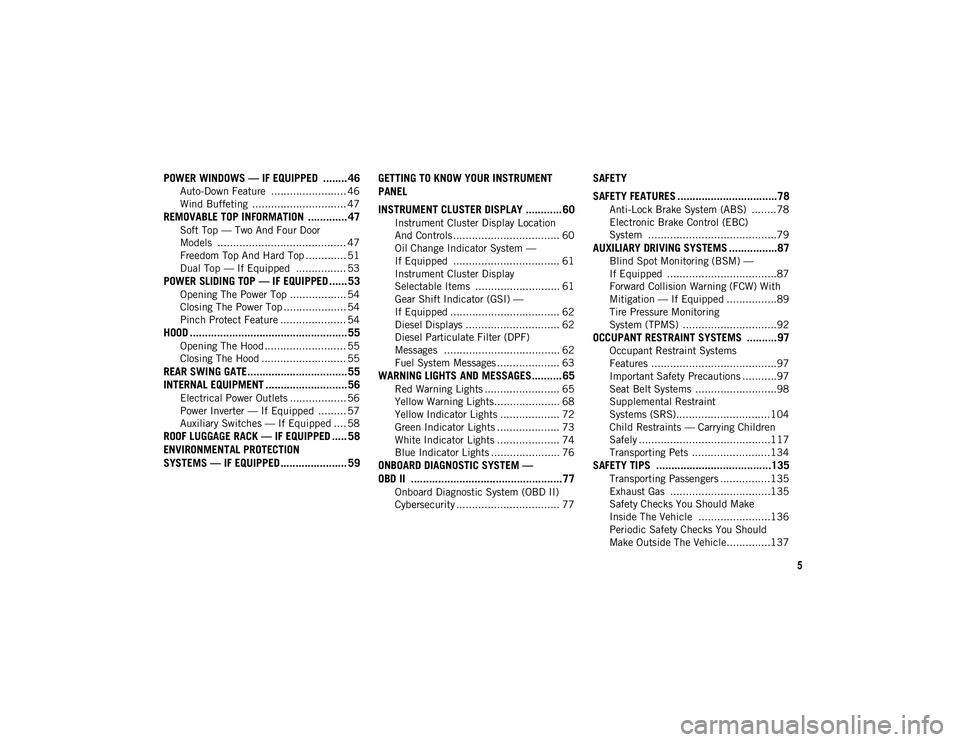
5
POWER WINDOWS — IF EQUIPPED ........ 46
Auto-Down Feature ........................ 46
Wind Buffeting .............................. 47
REMOVABLE TOP INFORMATION ............. 47
Soft Top — Two And Four Door
Models ......................................... 47 Freedom Top And Hard Top ............. 51
Dual Top — If Equipped ................ 53
POWER SLIDING TOP — IF EQUIPPED ...... 53
Opening The Power Top .................. 54
Closing The Power Top .................... 54
Pinch Protect Feature ..................... 54
HOOD .................................................... 55
Opening The Hood .......................... 55
Closing The Hood ........................... 55
REAR SWING GATE................................. 55
INTERNAL EQUIPMENT ........................... 56
Electrical Power Outlets .................. 56
Power Inverter — If Equipped ......... 57
Auxiliary Switches — If Equipped .... 58
ROOF LUGGAGE RACK — IF EQUIPPED ..... 58
ENVIRONMENTAL PROTECTION
SYSTEMS — IF EQUIPPED ...................... 59 GETTING TO KNOW YOUR INSTRUMENT
PANEL
INSTRUMENT CLUSTER DISPLAY ............ 60
Instrument Cluster Display Location
And Controls .................................. 60 Oil Change Indicator System —
If Equipped .................................. 61 Instrument Cluster Display
Selectable Items ........................... 61 Gear Shift Indicator (GSI) —
If Equipped ................................... 62 Diesel Displays .............................. 62
Diesel Particulate Filter (DPF)
Messages ..................................... 62 Fuel System Messages .................... 63
WARNING LIGHTS AND MESSAGES.......... 65
Red Warning Lights ........................ 65
Yellow Warning Lights..................... 68
Yellow Indicator Lights ................... 72
Green Indicator Lights .................... 73
White Indicator Lights .................... 74
Blue Indicator Lights ...................... 76
ONBOARD DIAGNOSTIC SYSTEM —
OBD II ..................................................77
Onboard Diagnostic System (OBD II)
Cybersecurity ................................. 77
SAFETY
SAFETY FEATURES .................................78
Anti-Lock Brake System (ABS) ........78
Electronic Brake Control (EBC)
System .........................................79
AUXILIARY DRIVING SYSTEMS ................87
Blind Spot Monitoring (BSM) —
If Equipped ...................................87 Forward Collision Warning (FCW) With
Mitigation — If Equipped ................89 Tire Pressure Monitoring
System (TPMS) ..............................92
OCCUPANT RESTRAINT SYSTEMS ..........97
Occupant Restraint Systems
Features ........................................97 Important Safety Precautions ...........97
Seat Belt Systems ..........................98
Supplemental Restraint
Systems (SRS)..............................104 Child Restraints — Carrying Children
Safely ..........................................117 Transporting Pets .........................134
SAFETY TIPS ......................................135
Transporting Passengers ................135
Exhaust Gas ................................135
Safety Checks You Should Make
Inside The Vehicle .......................136 Periodic Safety Checks You Should
Make Outside The Vehicle..............137
2020_JEEP_JL_WRANGLER_UG_RHD_UK.book Page 5
Page 8 of 330
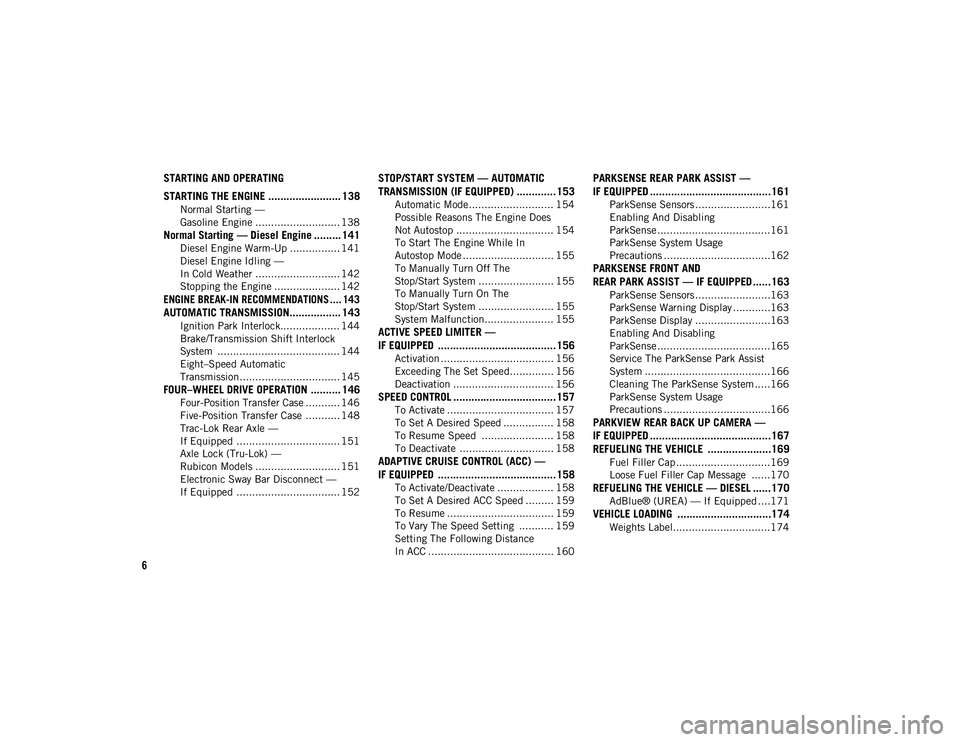
6
STARTING AND OPERATING
STARTING THE ENGINE ........................ 138
Normal Starting —
Gasoline Engine ........................... 138
Normal Starting — Diesel Engine ......... 141
Diesel Engine Warm-Up ................ 141
Diesel Engine Idling —
In Cold Weather ........................... 142 Stopping the Engine ..................... 142
ENGINE BREAK-IN RECOMMENDATIONS .... 143
AUTOMATIC TRANSMISSION................. 143
Ignition Park Interlock................... 144
Brake/Transmission Shift Interlock
System ....................................... 144 Eight–Speed Automatic
Transmission................................ 145
FOUR–WHEEL DRIVE OPERATION .......... 146
Four-Position Transfer Case ........... 146
Five-Position Transfer Case ........... 148
Trac-Lok Rear Axle —
If Equipped ................................. 151 Axle Lock (Tru-Lok) —
Rubicon Models ........................... 151 Electronic Sway Bar Disconnect —
If Equipped ................................. 152
STOP/START SYSTEM — AUTOMATIC
TRANSMISSION (IF EQUIPPED) .............153
Automatic Mode ........................... 154
Possible Reasons The Engine Does
Not Autostop ............................... 154 To Start The Engine While In
Autostop Mode ............................. 155 To Manually Turn Off The
Stop/Start System ........................ 155 To Manually Turn On The
Stop/Start System ........................ 155 System Malfunction...................... 155
ACTIVE SPEED LIMITER —
IF EQUIPPED .......................................156
Activation .................................... 156
Exceeding The Set Speed.............. 156
Deactivation ................................ 156
SPEED CONTROL ..................................157
To Activate .................................. 157
To Set A Desired Speed ................ 158
To Resume Speed ....................... 158
To Deactivate .............................. 158
ADAPTIVE CRUISE CONTROL (ACC) —
IF EQUIPPED .......................................158
To Activate/Deactivate .................. 158
To Set A Desired ACC Speed ......... 159
To Resume .................................. 159
To Vary The Speed Setting ........... 159
Setting The Following Distance
In ACC ........................................ 160
PARKSENSE REAR PARK ASSIST —
IF EQUIPPED ........................................161
ParkSense Sensors ........................161
Enabling And Disabling
ParkSense ....................................161 ParkSense System Usage
Precautions ..................................162
PARKSENSE FRONT AND
REAR PARK ASSIST — IF EQUIPPED ......163
ParkSense Sensors ........................163
ParkSense Warning Display ............163
ParkSense Display ........................163
Enabling And Disabling
ParkSense ....................................165 Service The ParkSense Park Assist
System ........................................166 Cleaning The ParkSense System .....166
ParkSense System Usage
Precautions ..................................166
PARKVIEW REAR BACK UP CAMERA —
IF EQUIPPED ........................................167
REFUELING THE VEHICLE .....................169
Fuel Filler Cap ..............................169
Loose Fuel Filler Cap Message ......170
REFUELING THE VEHICLE — DIESEL ......170
AdBlue® (UREA) — If Equipped ....171
VEHICLE LOADING ...............................174
Weights Label...............................174
2020_JEEP_JL_WRANGLER_UG_RHD_UK.book Page 6
Page 10 of 330
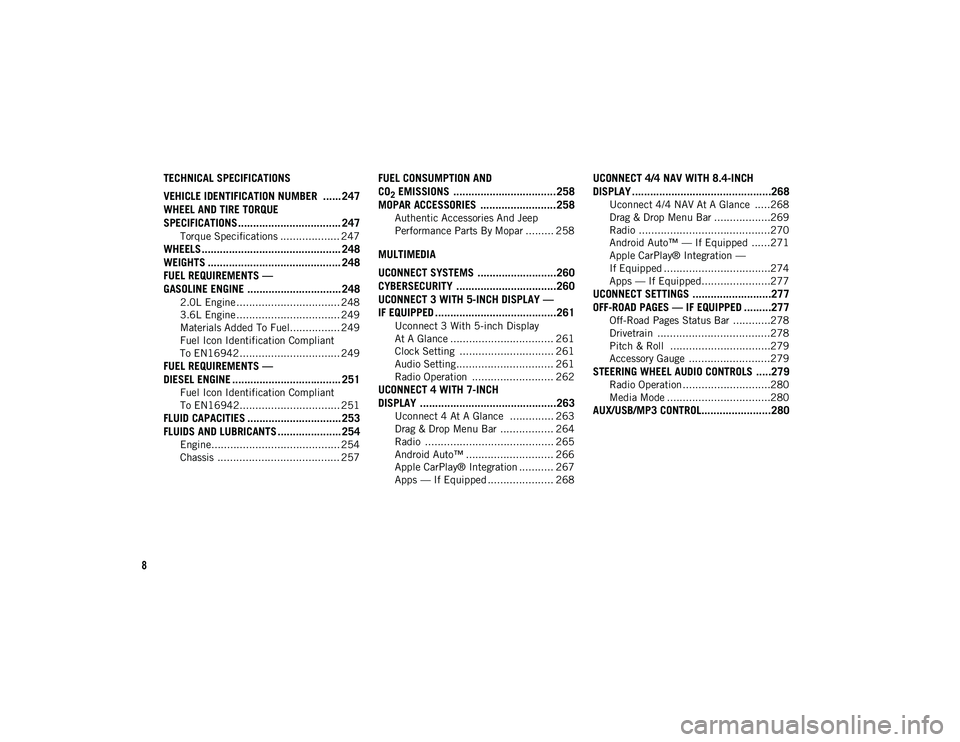
8
TECHNICAL SPECIFICATIONS
VEHICLE IDENTIFICATION NUMBER ...... 247
WHEEL AND TIRE TORQUE
SPECIFICATIONS .................................. 247
Torque Specifications ................... 247
WHEELS .............................................. 248
WEIGHTS ............................................ 248FUEL REQUIREMENTS —
GASOLINE ENGINE ............................... 248
2.0L Engine ................................. 248
3.6L Engine ................................. 249
Materials Added To Fuel................ 249
Fuel Icon Identification Compliant
To EN16942................................ 249
FUEL REQUIREMENTS —
DIESEL ENGINE .................................... 251
Fuel Icon Identification Compliant
To EN16942................................ 251
FLUID CAPACITIES ............................... 253 FLUIDS AND LUBRICANTS ..................... 254
Engine......................................... 254
Chassis ....................................... 257
FUEL CONSUMPTION AND
CO
2 EMISSIONS ..................................258
MOPAR ACCESSORIES .........................258
Authentic Accessories And Jeep
Performance Parts By Mopar ......... 258
MULTIMEDIA
UCONNECT SYSTEMS ..........................260
CYBERSECURITY .................................260
UCONNECT 3 WITH 5-INCH DISPLAY —
IF EQUIPPED ........................................261
Uconnect 3 With 5-inch Display
At A Glance ................................. 261 Clock Setting .............................. 261
Audio Setting............................... 261
Radio Operation .......................... 262
UCONNECT 4 WITH 7-INCH
DISPLAY .............................................263
Uconnect 4 At A Glance .............. 263
Drag & Drop Menu Bar ................. 264
Radio ......................................... 265
Android Auto™ ............................ 266
Apple CarPlay® Integration ........... 267
Apps — If Equipped ..................... 268
UCONNECT 4/4 NAV WITH 8.4-INCH
DISPLAY ..............................................268
Uconnect 4/4 NAV At A Glance .....268
Drag & Drop Menu Bar ..................269
Radio ..........................................270
Android Auto™ — If Equipped ......271
Apple CarPlay® Integration —
If Equipped ..................................274 Apps — If Equipped......................277
UCONNECT SETTINGS ..........................277OFF-ROAD PAGES — IF EQUIPPED .........277
Off-Road Pages Status Bar ............278
Drivetrain ....................................278
Pitch & Roll ................................279
Accessory Gauge ..........................279
STEERING WHEEL AUDIO CONTROLS .....279
Radio Operation ............................280
Media Mode .................................280
AUX/USB/MP3 CONTROL.......................280
2020_JEEP_JL_WRANGLER_UG_RHD_UK.book Page 8
Page 13 of 330
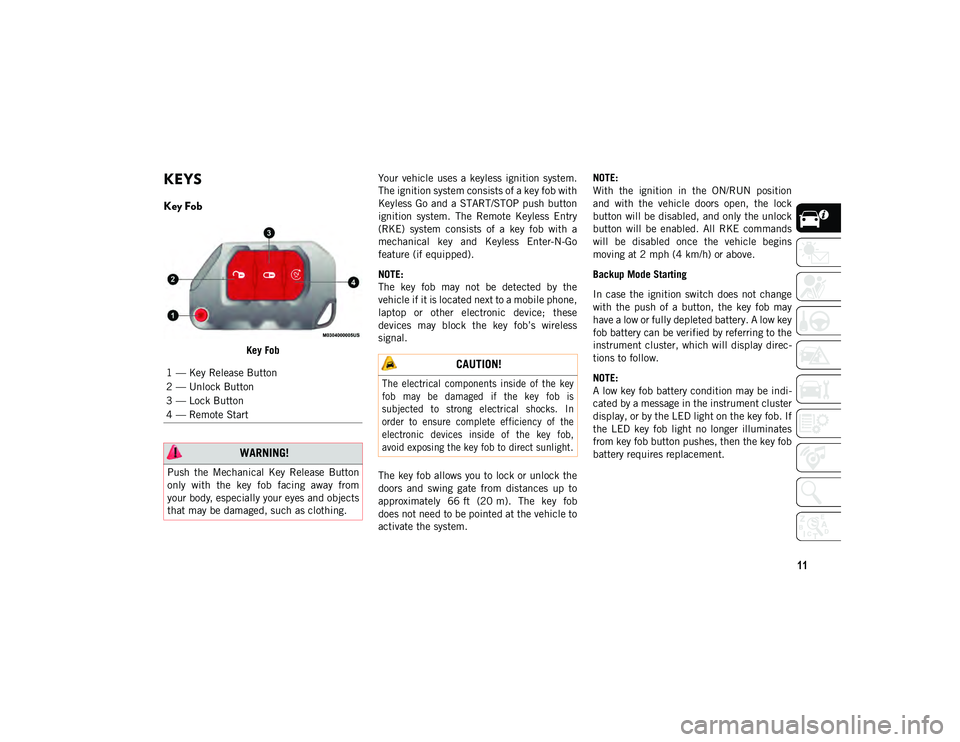
11
GETTING TO KNOW YOUR VEHICLE
KEYS
Key Fob
Key FobYour vehicle uses a keyless ignition system.
The ignition system consists of a key fob with
Keyless Go and a START/STOP push button
ignition system. The Remote Keyless Entry
(RKE) system consists of a key fob with a
mechanical key and Keyless Enter-N-Go
feature (if equipped).
NOTE:
The key fob may not be detected by the
vehicle if it is located next to a mobile phone,
laptop or other electronic device; these
devices may block the key fob’s wireless
signal.
The key fob allows you to lock or unlock the
doors and swing gate from distances up to
approximately 66 ft (20 m). The key fob
does not need to be pointed at the vehicle to
activate the system. NOTE:
With the ignition in the ON/RUN position
and with the vehicle doors open, the lock
button will be disabled, and only the unlock
button will be enabled. All RKE commands
will be disabled once the vehicle begins
moving at 2 mph (4 km/h) or above.
Backup Mode Starting
In case the ignition switch does not change
with the push of a button, the key fob may
have a low or fully depleted battery. A low key
fob battery can be verified by referring to the
instrument cluster, which will display direc
-
tions to follow.
NOTE:
A low key fob battery condition may be indi -
cated by a message in the instrument cluster
display, or by the LED light on the key fob. If
the LED key fob light no longer illuminates
from key fob button pushes, then the key fob
battery requires replacement.
1 — Key Release Button
2 — Unlock Button
3 — Lock Button
4 — Remote Start
WARNING!
Push the Mechanical Key Release Button
only with the key fob facing away from
your body, especially your eyes and objects
that may be damaged, such as clothing.
CAUTION!
The electrical components inside of the key
fob may be damaged if the key fob is
subjected to strong electrical shocks. In
order to ensure complete efficiency of the
electronic devices inside of the key fob,
avoid exposing the key fob to direct sunlight.
2020_JEEP_JL_WRANGLER_UG_RHD_UK.book Page 11
Page 23 of 330
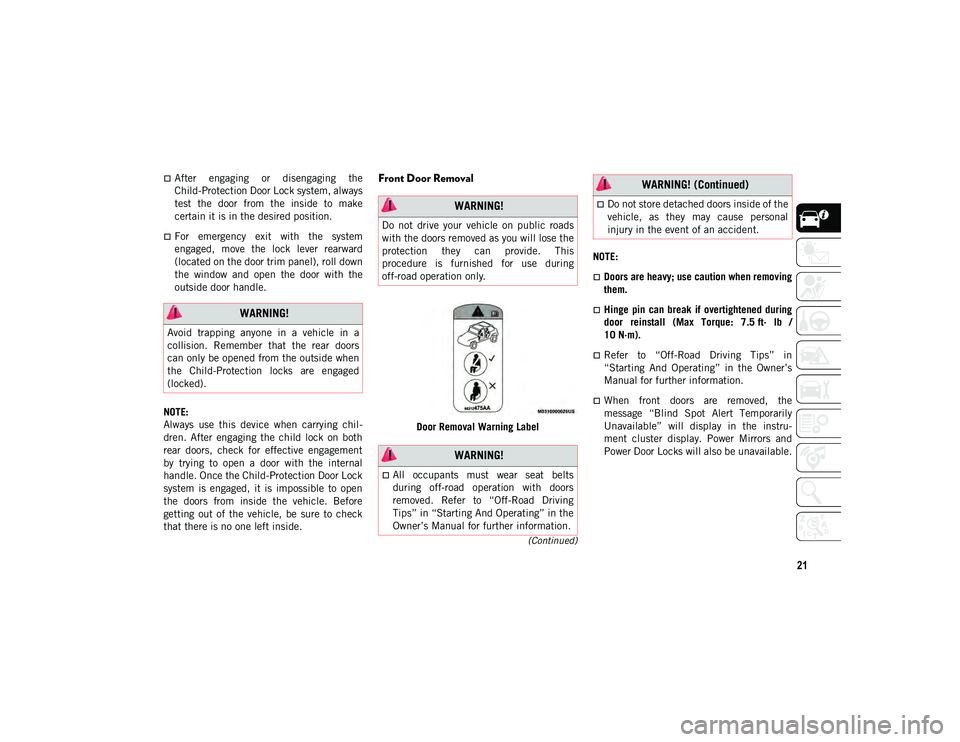
21
(Continued)
After engaging or disengaging the
Child-Protection Door Lock system, always
test the door from the inside to make
certain it is in the desired position.
For emergency exit with the system
engaged, move the lock lever rearward
(located on the door trim panel), roll down
the window and open the door with the
outside door handle.
NOTE:
Always use this device when carrying chil -
dren. After engaging the child lock on both
rear doors, check for effective engagement
by trying to open a door with the internal
handle. Once the Child-Protection Door Lock
system is engaged, it is impossible to open
the doors from inside the vehicle. Before
getting out of the vehicle, be sure to check
that there is no one left inside.
Front Door Removal
Door Removal Warning Label NOTE:
Doors are heavy; use caution when removing
them.
Hinge pin can break if overtightened during
door reinstall (Max Torque: 7.5 ft· lb /
10 N·m).
Refer to “Off-Road Driving Tips” in
“Starting And Operating” in the Owner’s
Manual for further information.
When front doors are removed, the
message “Blind Spot Alert Temporarily
Unavailable” will display in the instru
-
ment cluster display. Power Mirrors and
Power Door Locks will also be unavailable.
WARNING!
Avoid trapping anyone in a vehicle in a
collision. Remember that the rear doors
can only be opened from the outside when
the Child-Protection locks are engaged
(locked).
WARNING!
Do not drive your vehicle on public roads
with the doors removed as you will lose the
protection they can provide. This
procedure is furnished for use during
off-road operation only.
WARNING!
All occupants must wear seat belts
during off-road operation with doors
removed. Refer to “Off-Road Driving
Tips” in “Starting And Operating” in the
Owner’s Manual for further information.
Do not store detached doors inside of the
vehicle, as they may cause personal
injury in the event of an accident.
WARNING! (Continued)
2020_JEEP_JL_WRANGLER_UG_RHD_UK.book Page 21
Page 39 of 330
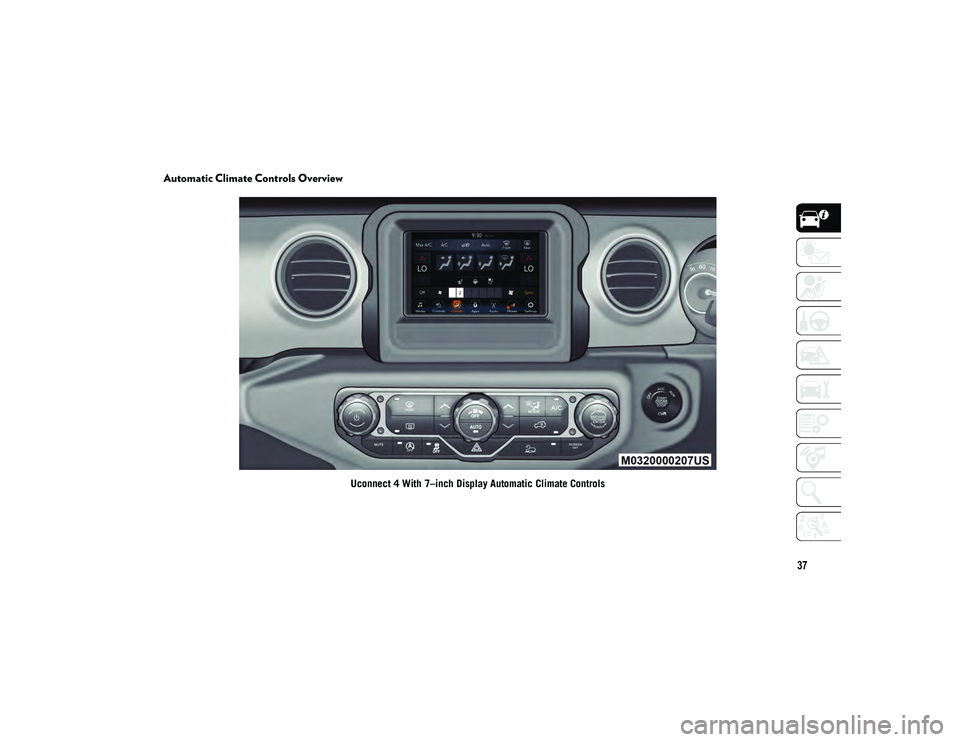
37
Automatic Climate Controls Overview
Uconnect 4 With 7–inch Display Automatic Climate Controls
2020_JEEP_JL_WRANGLER_UG_RHD_UK.book Page 37
Page 40 of 330
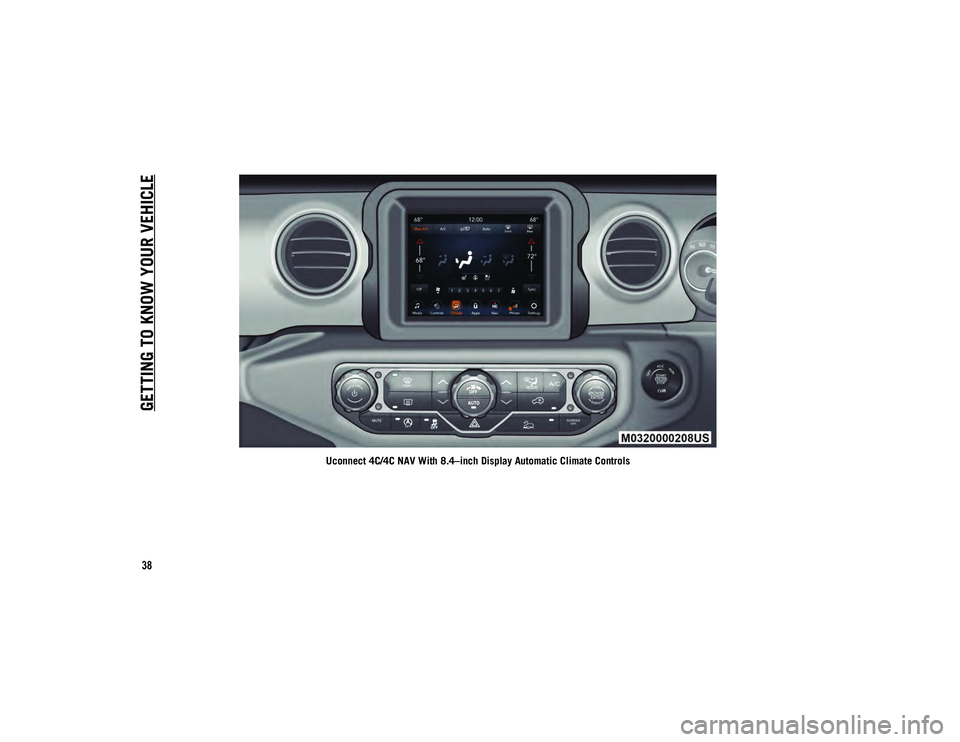
GETTING TO KNOW YOUR VEHICLE
38
Uconnect 4C/4C NAV With 8.4–inch Display Automatic Climate Controls
2020_JEEP_JL_WRANGLER_UG_RHD_UK.book Page 38
Page 46 of 330
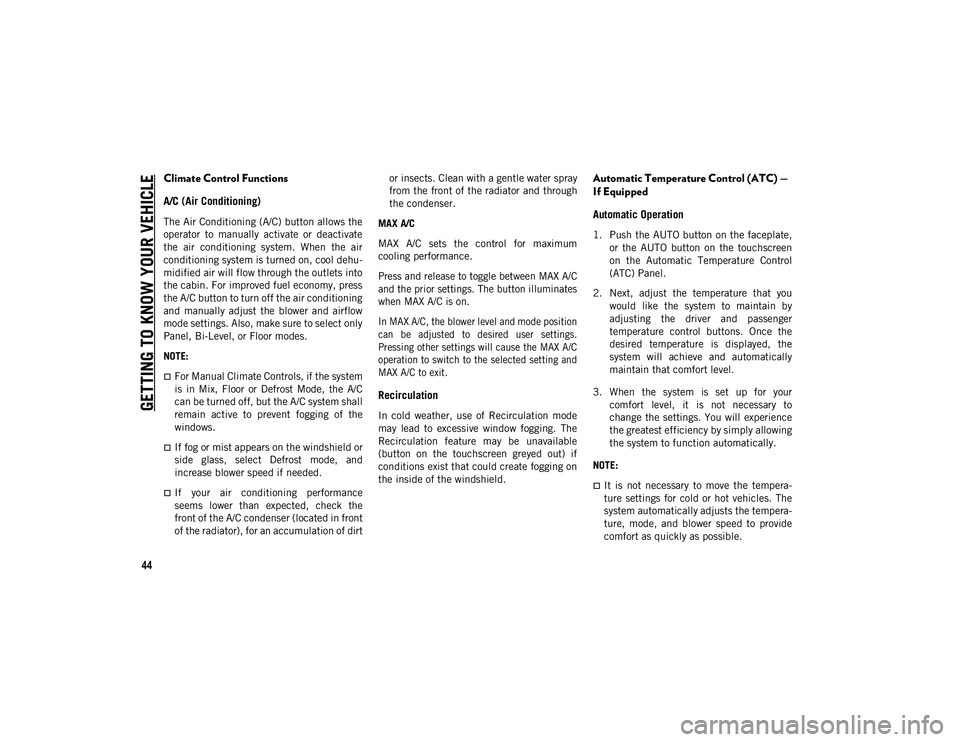
GETTING TO KNOW YOUR VEHICLE
44
Climate Control Functions
A/C (Air Conditioning)
The Air Conditioning (A/C) button allows the
operator to manually activate or deactivate
the air conditioning system. When the air
conditioning system is turned on, cool dehu-
midified air will flow through the outlets into
the cabin. For improved fuel economy, press
the A/C button to turn off the air conditioning
and manually adjust the blower and airflow
mode settings. Also, make sure to select only
Panel, Bi-Level, or Floor modes.
NOTE:
For Manual Climate Controls, if the system
is in Mix, Floor or Defrost Mode, the A/C
can be turned off, but the A/C system shall
remain active to prevent fogging of the
windows.
If fog or mist appears on the windshield or
side glass, select Defrost mode, and
increase blower speed if needed.
If your air conditioning performance
seems lower than expected, check the
front of the A/C condenser (located in front
of the radiator), for an accumulation of dirt or insects. Clean with a gentle water spray
from the front of the radiator and through
the condenser.
MAX A/C
MAX A/C sets the control for maximum
cooling performance.
Press and release to toggle between MAX A/C
and the prior settings. The button illuminates
when MAX A/C is on.
In MAX A/C, the blower level and mode position
can be adjusted to desired user settings.
Pressing other settings will cause the MAX A/C
operation to switch to the selected setting and
MAX A/C to exit.
Recirculation
In cold weather, use of Recirculation mode
may lead to excessive window fogging. The
Recirculation feature may be unavailable
(button on the touchscreen greyed out) if
conditions exist that could create fogging on
the inside of the windshield.
Automatic Temperature Control (ATC) —
If Equipped
Automatic Operation
1. Push the AUTO button on the faceplate, or the AUTO button on the touchscreen
on the Automatic Temperature Control
(ATC) Panel.
2. Next, adjust the temperature that you would like the system to maintain by
adjusting the driver and passenger
temperature control buttons. Once the
desired temperature is displayed, the
system will achieve and automatically
maintain that comfort level.
3. When the system is set up for your comfort level, it is not necessary to
change the settings. You will experience
the greatest efficiency by simply allowing
the system to function automatically.
NOTE:
It is not necessary to move the tempera-
ture settings for cold or hot vehicles. The
system automatically adjusts the tempera-
ture, mode, and blower speed to provide
comfort as quickly as possible.
2020_JEEP_JL_WRANGLER_UG_RHD_UK.book Page 44
Page 47 of 330
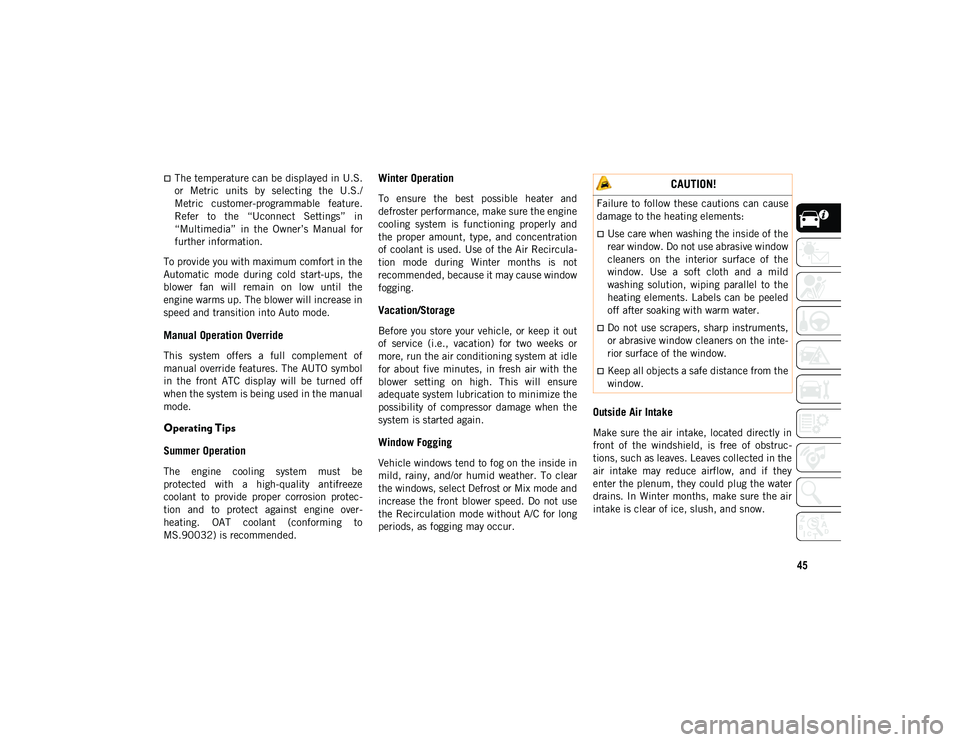
45
The temperature can be displayed in U.S.
or Metric units by selecting the U.S./
Metric customer-programmable feature.
Refer to the “Uconnect Settings” in
“Multimedia” in the Owner’s Manual for
further information.
To provide you with maximum comfort in the
Automatic mode during cold start-ups, the
blower fan will remain on low until the
engine warms up. The blower will increase in
speed and transition into Auto mode.
Manual Operation Override
This system offers a full complement of
manual override features. The AUTO symbol
in the front ATC display will be turned off
when the system is being used in the manual
mode.
Operating Tips
Summer Operation
The engine cooling system must be
protected with a high-quality antifreeze
coolant to provide proper corrosion protec -
tion and to protect against engine over -
heating. OAT coolant (conforming to
MS.90032) is recommended.
Winter Operation
To ensure the best possible heater and
defroster performance, make sure the engine
cooling system is functioning properly and
the proper amount, type, and concentration
of coolant is used. Use of the Air Recircula -
tion mode during Winter months is not
recommended, because it may cause window
fogging.
Vacation/Storage
Before you store your vehicle, or keep it out
of service (i.e., vacation) for two weeks or
more, run the air conditioning system at idle
for about five minutes, in fresh air with the
blower setting on high. This will ensure
adequate system lubrication to minimize the
possibility of compressor damage when the
system is started again.
Window Fogging
Vehicle windows tend to fog on the inside in
mild, rainy, and/or humid weather. To clear
the windows, select Defrost or Mix mode and
increase the front blower speed. Do not use
the Recirculation mode without A/C for long
periods, as fogging may occur.
Outside Air Intake
Make sure the air intake, located directly in
front of the windshield, is free of obstruc -
tions, such as leaves. Leaves collected in the
air intake may reduce airflow, and if they
enter the plenum, they could plug the water
drains. In Winter months, make sure the air
intake is clear of ice, slush, and snow.
CAUTION!
Failure to follow these cautions can cause
damage to the heating elements:
Use care when washing the inside of the
rear window. Do not use abrasive window
cleaners on the interior surface of the
window. Use a soft cloth and a mild
washing solution, wiping parallel to the
heating elements. Labels can be peeled
off after soaking with warm water.
Do not use scrapers, sharp instruments,
or abrasive window cleaners on the inte-
rior surface of the window.
Keep all objects a safe distance from the
window.
2020_JEEP_JL_WRANGLER_UG_RHD_UK.book Page 45
Page 61 of 330
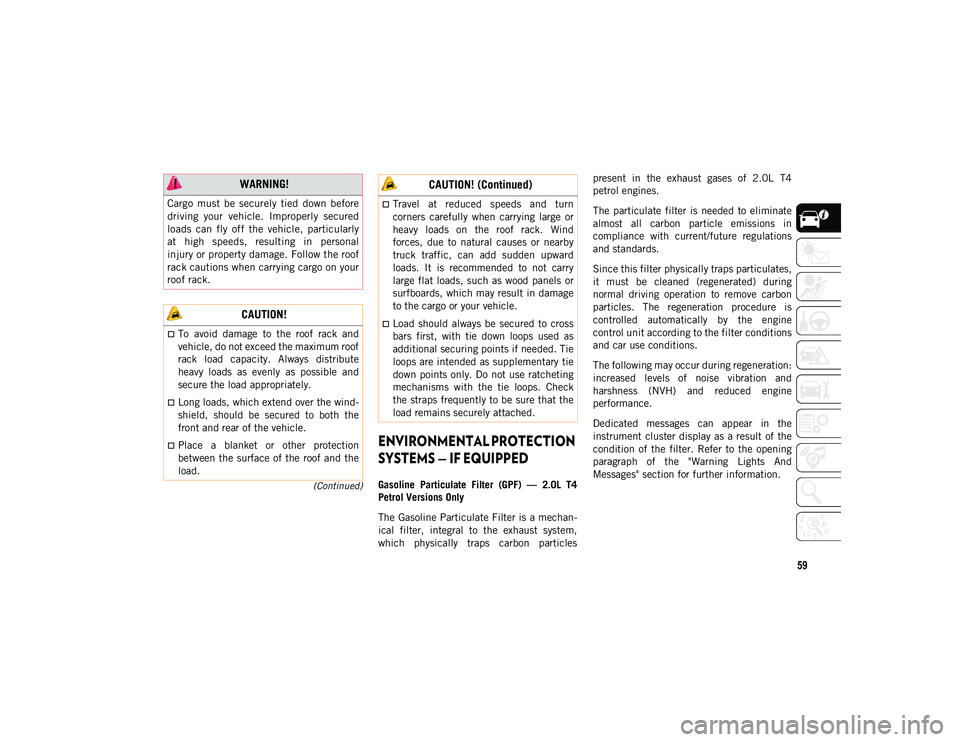
59
(Continued)
ENVIRONMENTAL PROTECTION
SYSTEMS — IF EQUIPPED
Gasoline Particulate Filter (GPF) — 2.0L T4
Petrol Versions Only
The Gasoline Particulate Filter is a mechan-
ical filter, integral to the exhaust system,
which physically traps carbon particles present in the exhaust gases of 2.0L T4
petrol engines.
The particulate filter is needed to eliminate
almost all carbon particle emissions in
compliance with current/future regulations
and standards.
Since this filter physically traps particulates,
it must be cleaned (regenerated) during
normal driving operation to remove carbon
particles. The regeneration procedure is
controlled automatically by the engine
control unit according to the filter conditions
and car use conditions.
The following may occur during regeneration:
increased levels of noise vibration and
harshness (NVH) and reduced engine
performance.
Dedicated messages can appear in the
instrument cluster display as a result of the
condition of the filter. Refer to the opening
paragraph of the "Warning Lights And
Messages" section for further information.
WARNING!
Cargo must be securely tied down before
driving your vehicle. Improperly secured
loads can fly off the vehicle, particularly
at high speeds, resulting in personal
injury or property damage. Follow the roof
rack cautions when carrying cargo on your
roof rack.
CAUTION!
To avoid damage to the roof rack and
vehicle, do not exceed the maximum roof
rack load capacity. Always distribute
heavy loads as evenly as possible and
secure the load appropriately.
Long loads, which extend over the wind
-
shield, should be secured to both the
front and rear of the vehicle.
Place a blanket or other protection
between the surface of the roof and the
load.
Travel at reduced speeds and turn
corners carefully when carrying large or
heavy loads on the roof rack. Wind
forces, due to natural causes or nearby
truck traffic, can add sudden upward
loads. It is recommended to not carry
large flat loads, such as wood panels or
surfboards, which may result in damage
to the cargo or your vehicle.
Load should always be secured to cross
bars first, with tie down loops used as
additional securing points if needed. Tie
loops are intended as supplementary tie
down points only. Do not use ratcheting
mechanisms with the tie loops. Check
the straps frequently to be sure that the
load remains securely attached.
CAUTION! (Continued)
2020_JEEP_JL_WRANGLER_UG_RHD_UK.book Page 59